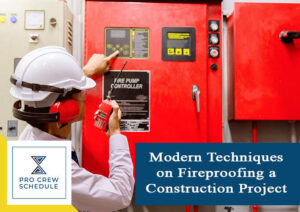Fire is among the worst enemies of any property. For that reason, fire prevention should be among the top priorities of project owners and building contractors when planning and managing construction works.
According to the CDC, over 2,500 people are killed every year in residential fires in the United States. We rarely hear a construction site caught on fire, but the statistics mentioned above could result from poor fire prevention during construction. While no building material’s entirely fireproof, new materials developed that can resist fire for a certain period and slow down the spread of fire. These materials can, at least, save lives and possibly the building until rescue arrives.
That said, a fire-safe building greatly depends on the fire prevention techniques applied during the construction phase. And today, we’re going to look into the newer fireproofing strategies used by developers in their projects.
New Fire Engineering Techniques
Most countries are now embracing modern fire engineering as an essential part of their construction process. International manufacturer of fire protective systems AKRONEX International Fire Engineering Inc. believes that building owners should invest in modern fire systems. These systems are proven to be more effective in protecting projects and human life than traditional fire-fighting strategies.
That said, let’s now look into the new and better ways of fireproofing construction projects.
I – General Fireproofing Techniques
1. Smarter Project Planning
A construction project’s success and safety can be determined as early as the planning stage. The client and the construction team decide on the project design, materials, technology, and processes during this stage. Hence, one can already predict the future of the structure. Will it be strong enough to withstand the works of nature? And in this case, will it be resistant to fire?
A building’s failure to resist fire can be a result of several inaccuracies during the planning stage. First, forecasting the proper equipment to extinguish a fire is quite challenging as we can’t tell what type of fire will break out in a building. To protect the project from burning to ashes, designers and project engineers should consider all types of fire that can destroy the chosen building materials and, from there, plan for the right extinguishing systems. BIM will be useful during this stage for testing the effectiveness of materials and the fire system.
Additionally, the lack of knowledge on the new trends in suppressing fire and the inability to enforce fire safety regulations can negatively impact the building’s fire safety. Unfortunately, when developers decide to cut corners in their project, fire safety is among the many aspects compromised. The budget for procuring better fire safety equipment and their installation are cut down, hence lowering the building’s fireproofing quality.
Finally, construction companies should adopt modern fire engineering practices to ensure that the project uses the right systems and that they are adequately maintained throughout the building’s lifetime. Fire engineering practices should include accurate risk assessment, well-designed fire system design, well-chosen fire equipment, and keener site supervision.
2. New Fire Detection Technologies
There are new trends in fire safety engineering observed by construction companies worldwide where the emphasis is placed on people’s safety than the building. That said, escape routes and evacuation methods are improved, and so as the materials used in construction.
Among the latest fire detection technologies, the flexible drop is gaining popularity among project managers. This bent hose can significantly reduce installation time and requires fewer crew members from the piping subcontractor to work on the construction site. It also reduces the chances for rework as it is easily repositioned even after the ceiling has been installed.
3. Modern Water Mist Technology
Another innovation in the fire safety engineering field that construction companies should adopt is water mist technology. It is a growing trend, especially in Africa, for protecting museums, heritage buildings, libraries, and other non-building structures like road tunnels.
The principle of this technology is simple. Water mist systems operate at pressures equal to 100 bar and use pure water for suppressing fire. They are equipped with specially designed nozzles, which form fine water droplets smaller than 100 microns. Unlike conventional sprinklers, water mist systems increase the cooling effect dramatically while reducing the amount of water required for putting off the fire by 10%.
II – Fireproofing Steel Structures
There is a growing demand for steel structures in the US, especially in the commercial and industrial sectors. Fireproofing them is somehow different from concrete and wood structures as steel behaves differently around heat and fire.
Though steel can withstand high temperatures, some structural fire can exceed 800°C. It is way higher than a steel’s tolerable temperature of 550°C before experiencing a decline in its load-bearing properties. At such temperature, steel also loses its yield strength and buckle. Consequently, steel starts to bend and twist until it finally collapses.
Steel frames that are unprotected by any fireproofing methods can resist fire for 15 minutes before they fail. However, industry fireproofing requirements need structural steel to withstand fire longer than the said period.
The required fire-resisting period for steel structure may vary depending on the size and purpose of the building. For example, offices that are higher than 30 meters, installed with sprinklers, and accommodate so many people should withstand fire for at least 120 minutes. On the other hand, residential structures have different requirements.
Steel beams have a different story. They used to be encased in concrete for higher fire protection until the 1970s. But due to its effect on the environment, its weight, and its effect on the body’s flexural strength, there has been a demand for more lightweight solutions like using Engineered Cementitious Composite- Light Weight Concrete to replace regular cement.
At present, though, other materials are being used to fireproof steel beams. They include the use of:
- intumescent paints
- fireproof boards
- fire-stopping sprays
1. Intumescent Coatings
This fireproofing solution for steel can only be applied by intumescent paint contractors. Today, these coatings serve to be the most widely-used structural steel protection technology in the UK.
An intumescent coating contains elements that react and can resist high temperatures. Once it is exposed to fire, its density increases drastically. Hence, it can provide additional protection to steel beams.
Intumescent coatings come in two forms:
- Thin Film: Intumescent coating that is solvent or water-based. This type is commonly used in buildings.
- Thick Film: This is preferred by industries that deal with extreme temperatures like the petroleum industry.
2. Fireproof Boards
In scenarios where intumescent paints are not viable solutions, fireproof boards can be used. These boards can protect structural steel columns from fire for up to 240 minutes and up to 180 minutes for steel beams.
These boards replace concrete in wrapping steel beams, decking, and columns for fireproofing. They are usually made of rigid mineral-based wood. Steel contractors usually install them while steel is being erected or installed on the structure. It can be a cost-efficient fireproofing material as it doesn’t require ventilation, reducing additional costs for structural fire protection.
3. Fire-stopping Sprays
Using a fire-stopping spray is another simple structural steel fireproofing solution that’s more cost-effective than the first two techniques. These sprays are typically mineral-based, but some are made from low-density cement compounds.
For fire-stopping sprays to be more effective, a thickness range between 10mm and 70mm should be observed when applied to the steel structure. Surprisingly, these sprays can protect steel for up to 240 minutes when exposed to fire. And for a stronger effect, remember to apply acrylic copolymer.
In addition to fireproofing steel, these sprays can also increase soundproofing between walls and floors. Finally, fire-stopping sprays also work on other surfaces such as composite-based materials, fabric, and wood.
III. Use of Fire-resistant Materials
The use of fire-resistant materials is more common in construction sites. Two of the most commonly used materials to slow down fire from its travel are:
1. Stucco
Stucco is a common plaster type used for centuries in the construction and artistic scenes. Modern stucco serves as an excellent building finishing and fireproofing. It is made of sand, lime, and Portland cement and can be applied to several structural materials like wood and brick. It is also the best material for boxing roof eaves.
Applying a one-inch layer of stucco can make a surface resistant to fire for up to an hour.
2. Gypsum Board/Drywall
Gypsum sheathing is required for most structural materials to achieve an excellent fire-resistant rating. It is a common material used as a fireproof interior finish.
Drywall is an assembly of gypsum tucked in between sheets of paper. Type X Gypsum is a better type as it is treated with additives to enhance the board’s fire-resistive qualities. The exterior paper sheets of Type X Gypsum tend to burn slowly. Furthermore, the board contains chemically combined water, which is excreted as steam when exposed to fire. As a result, heat transfer through the gypsum board is impeded.
Final Thoughts
In reality, there’s no completely fireproof building material. The so-called fire-resistant materials only slow down fire from taking effect to allow occupants to escape.
And it is the fire rating of construction materials that determines the period that they can withstand the impact of fire. The higher the rating, the longer time it takes for a fire to damage it. And while there are indeed materials used in construction that are non-combustible such as aluminum steel, they still buckle when exposed to an intense heat brought about by industrial fire.
The key to saving lives and structures is to choose a construction material that will impede fire from scattering rapidly. So, plan your design and materials well, choose modern fire mitigation equipment, observe fire engineering practices, and use fire-resistant elements in your project.







